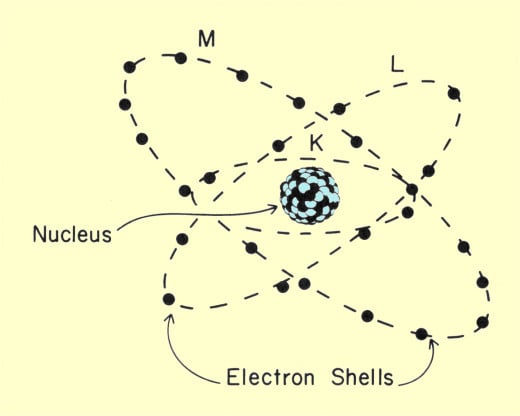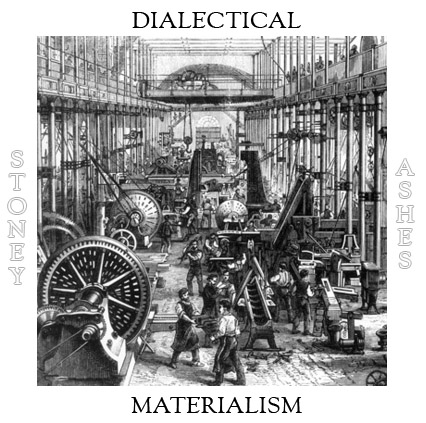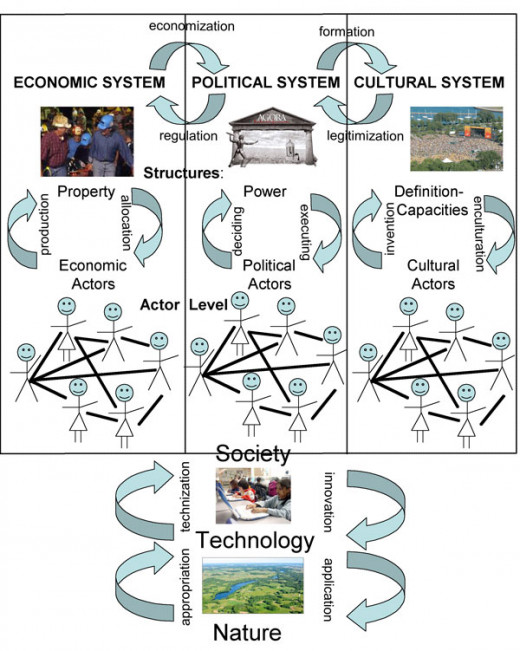Dialectical Materialism







Idealistic Naturalism and Dialectical Naturalism
In our contemporary era where we now stand on the shoulders of people like Marx, Proudhon, Plekanov, Hegel, Lao Tse, Einstein, Planck, Tesla and countless others, we can come to a deeper appreciation of dialectical naturalism aka dialectical materialism. If we want to define the cosmos and all therein as the expression of dialectical materialism then we have to come to terms of what exactly matter is and how it functions in manifestation. It is now known that that at the quantum level, the atomic and sub-atomic is more seeming empty space alive with vibration of polar opposing energies. A curious balance is struck between positive and negative, matter and anti-matter interacting with and sustained by the Planck False Vacuum State and quantum foam that has an extremely high energy potential. Energy is given mass, which is our connection with the material cosmos, via the mass causing Higgs Boson and Higgs Field due to interaction with the electrodynamic cosmic field. We can touch the world at our hierarchical level and interact with it because everything is a field infused with mass. Mass is intertwined with gravity and the electromagnetic dynamic. As we are made of the same stuff, whether it is a star, a stone, an apple, a human being or anything else, we have direct material contact and thus our paradigm to us is solid and real. Yet, modern findings tell us that the cosmos and all that is in it including us is an electrodynamic tensor given mass due to the interaction of the Higgs Field intimately interpenetrating the quantum foam and manifest particles.
The sum of the quantum is composed of equal and opposite charge arranged in a stunning number of arrangements with variations of charge. The variation is of primal importance as it forms the basis of the difference in the fundamental elements and combinations thereof of the material cosmos. In this context of electrodynamics, we have life as well, which science is now coming to understand with how a living organism in a material cosmos can have consciousness to be able to sense, appreciate and interact with matter. As individuals and society, we come to many different views of the same material cosmos activated by energy of all kinds. It is not surprising that many views and definitions have arisen and such an occurrence is described in thorough detail by General Relativity (GR) by Einstein. Problems arise when people limit their paradigm to that which they alone have come to understand and persuade followers to adopt. The complexity of the quantum is carried up from there to the world of human experience where no two world outlooks are the same in totality. Each experience in the material world is different despite a large number of common agreements. The main problem here is the limits we try to impose upon a complex non linear material manifestation from a narrow and limited individual world view. Nothing exists in isolation despite our best efforts.
Egoism and ignorance can do great harm when if forces society to be constrained by a narrow world view. Historically and repeatedly, beautiful theories are shattered by a single glaring ugly fact that does not fit in. Historically too, ignorance has been exploited to allow the unscrupulous to rule. In the sphere of political economics, this emerges in the context of Marx, who thought that communism would naturally emerge from the most advanced capitalist states in the world. Given his thorough analysis in Kapital of how capitalism works, it is a natural conclusion to make, making a lot of sense in context. History in the unfolding of the economic dialectic, states that communism actually broke out at the breaking of capitalism's weakest link, that is, in Russia in February of 1917 that appears to have turned Marx upside down. The flash point occurred when women asking for bread from the Tsar were fired on by the military and police in the WWI war years in a particularly severe winter and famine. This was the touchstone of country wide revolution in Russia that was to have a huge impact on world capitalism long after. The Tsarist rule was to be smashed and liquidated by the emerging order. It took until October 1917 for the Bolsheviks of which Lenin was the leader, to take the reigns of the fledgeling Soviets' government. Thus the new state became the first workers' power that sustained itself in the sea of capitalism in the rest of the world. The capitalist world then in response to this economic dialectic shift, was to turn its attention away from the profiteering of WWI and toward the Union of Soviet Socialist Republics (USSR) in a new war to crush communism in the bud. They did not totally succeed. However, Lenin died in 1924 from complications of an earlier near fatal shooting and in 1927, Stalin consolidated power and cut deals with world capitalism turning the workers' state into a deformity of its former grandeur and purity. Nevertheless, advances from a peasant feudal order to a world order scientific socialist and technological marvel in direct competition with the USA was phenomenal in the span of half a century. Here we see the working of the natural dialectic in the material world through politics and economics, the idea of whether the physical resources are to be hoarded for individual profit or collectively shared by all. In the end, the Soviet Union was to collapse from external pressure and internal corruption, but before it did, several socialist states emerged on the world scene. Once again, in economically and politically backward countries, many that were formerly under imperialist domination by Britain, the US or other foreign capitalist powers moved away in revolution from capitalism to socialism-communism. These new states were deformed from the beginning having taken their inspiration from Stalin. There is one notable exception in the form of Cuba that began with violence from a legal bourgeois election defeat of Batista to Castro. Castro et al were to come under Stalinist influence directly due to the policies of the US that favoured Batista over Castro once the revolution had driven Batista out. The nature of the historic dialectic is complex and non-linear.
Material Dialectics works through history, used by the elite to manipulate real value out of the hands of the producers. This comes through economic manipulation that in the capitalist US, took the forms of Keynesian and Rand-Friedman economics that move in cyclic fashion, from liberal reforms to reforms of restraint and austerity. Economics are periodically subject to restraint-regulation and deregulation. The capitalist world manages to keep successive generations of producers ignorant and the political maneuverings moves back and forth from public welfare to corporate welfare, from bank regulation to deregulation and back again. To work the economy in such a manner to milk the producers takes great knowledge, planning and implies actual if not implied total control. This political-economic cycle revolves in 30 and 70 to 80 year cycles and shows itself in the history of the US with interpenetrating smaller cycles of boom and bust. But capitalism as an economic entity is fraught with contradiction and anarchy due to crises of overproduction and competition. This is something of a wild element suggesting that in part, understanding of this historic dynamic is incomplete. Historic and economic dialectics is moderated by natural dialectics that for the most part, functions outside of human control and intervention. We cannot control the solar cycles that impact everything on earth, which is born out in sediments, ice core records and even in the trees.
In a nutshell, the materialist dialectic must function on the same protocols as idealistic naturalism; that is to say, the three fundamental laws of the change of quantity to quality and vice versa, the interpenetration of opposites and the negation of the negation. For the first case in the historic and economic sphere, the addition of labour saving devices allows for the easing of production while at the same time increasing volume of production. Labour saving technology is the natural outgrowth of the need to increase efficiency in the capitalist sphere in order to cut costs and increase profits according to the analysis of Marx. But there is also a down side to increased production. Not as many labourers are needed and those left working must take on more work. So here is there is the change from quality to quantity. Another expression of this comes in the form of planned obsolescence. Quality is directly affected by built in failure either by engineered collapse or being outmoded by greater quality or fashion. Thus, to keep up with built in collapse, greater quantity or production is required by the capitalist. The modern capitalist production is fraught with under engineering so that there is a higher product-commodity turnover in order to enhance profits. The interpenetration of opposites comes into play as boss and worker constantly struggle with each other in a combined and unequal manner. The boss wants greater profits and will do anything to encourage this and the worker-producer sees this and wants more of the share in work benefits. History comes into the picture as the armed state intervenes to protect the boss and fights against workers organizing into unions. The work place under capitalist production is a constant polarization between boss and employee, the sometimes sees the boss closing shop and relocating to a more profitable venue. The capitalist state discourages worker run production for the same profit once claimed as the boss' right. This same productive capacity finds itself negated by new and better ways. The capitalist stuck with older machinery of commodity production will be easily outstripped by another with newer, more advanced production methods. The newer one in turn will be negated by ever better methods. Dialectics operates through history in all of these ways in the class struggle, upon which Marx had much to say.
Class struggle through history is typically regulated through the device of nationalistic wars. The capitalist seeks to be international in the modern world of imperialist adventurism. Investments and production can easily shift from country to country where profit is greatest in potential. But this can only be effective if most of us are divided in national enclaves that compete and war with one another. Dividing people along a host of prejudices and the fear of the alien are tools used in order to keep people at war with each other rather than the bosses. The really clever and powerful ones actually use war and profits from both sides. The modern era sees the heaviest investment in war. War fever also means drumming up patriotic and nationalistic sentiments. Thus, the working class has been historically placed as the negation of one another by the elite, when in fact, the real war is the manipulations of the class war is of elite against the workers of the world, divided artificially into warring enclaves for profit.
The role of religion, almost all of which is medievalist nonsense, is carried forward through history to placate the ignorant. There is a natural awe in life and consciousness, but it rarely has anything to do with invented mumbo jumbo. As such, religion is a tool of the state to keep the miserable in a state of combined hope and terror so that they are more easily manipulated, Religion has its source in the study of the real cosmos and was behind the foundation of science, but priest-craft has severed that from its roots and moved it to supernaturalism. It follows in the dialectics of history that humanity drifts back and forth between enlightenment and the darkness of superstition and ignorance. This unfolds through history in a number of ways. The old way of the ancestors are by and large forgotten knowledge and if we were for some reason to require it again, we would be lacking the very knowledge for survival with which they used in order to bring their children, us, into the world. Another way this happens is when nations are conquered, such as the First Nations and their ways and culture are deliberately destroyed and replaced with a new paradigm, that of the new masters. The same happened with the imported slaves, but in a different manner. Some of the old ways are preserved and integrated with the new. It can be said that the medieval religion has been replaced with a new religion, that of profit, wealth, power politics and science. The powers of nature are such that even scientists are in awe of the spectacle. In times of ignorance, those who wielded a bit more knowledge would exploit this, inventing, and by the personification of natural occurrences, create gods with superhuman qualities. This was the terror element needed for control and it is still in wide use in the age of science.
For a species apparently gifted with the ability to think and reason things out, we find for the most part that many people are either along for the ride, accept what pat answer is given, or are ignorant of the needed facts to reasonably work ideas out. The powerful and wealthy are already familiar with the materialist dialectic or dialectical naturalism and use this tool on the ignorant to manipulate history, economics and politics. The evidence is strewn in the past and near past as well as stated agendas for the future. If we but look, we can see how thesis, antithesis and synthesis all work in every sphere of life and nature.








